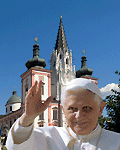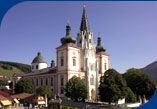ABSTRACT
As a liturgical opening of His visit to Austria, Pope Benedict XVI. is going to meet with the faithful for common prayer at "Am Hof" Square. In doing so, Benedict XVI. is not just going to visit one of the historically most important squares in Vienna's inner city - he is going to walk in the footsteps of his predecessors: "Am Hof" Square looks back on a long history of Papal visits. The former Apostolic Nunciature was located at "Am Hof" Square from 1630 to 1913, in which Antonio Pignatelli, the later Pope Innozenz XII., lived and worked from 1668 to 1671. In 1782, Pope Pius VI. stayed in Vienna for several weeks. On Easter Sunday in March 31, Pius VI. gave the Easter Blessing to thousands of faithful Christians from the balcony of "Am Hof" Church and granted full indulgence. On September 12, 1983, Pope John Paul II. arrived at "Am Hof" Square and met with Austrian workers and guest workers. The meeting was characterized by the deep ties to working class people. The Marian Column in the middle of "Am Hof" Square was erected in 1645. A bronze figure of the Maria Immaculata is placed on a square pedestal. Four armed "putti" (young boys) are successfully fighting a dragon (which symbolizes hunger), a lion (which stands for war), a snake (which symbolizes faithlessness), and a basilisk (known as a symbol of the plague).
_________________________________________________________________
Long Tradition of Papal Visits
On September 7, 2007, as a liturgical opening of His visit to Austria, Pope Benedict XVI. is going to meet with the faithful for common prayer at "Am Hof" Square. In doing so, Benedict XVI. is not just going to visit one of the historically most important squares in Vienna's inner city - he is going to walk in the footsteps of his predecessors: "Am Hof" Square looks back on a long history of Papal visits. The former Apostolic Nunciature was located at "Am Hof" Square from 1630 to 1913, in which Antonio Pignatelli, the later Pope Innozenz XII., had lived and worked from 1668 to 1671.
In 1782, Pope Pius VI. stayed in Vienna for several weeks. On Easter Sunday in March 31, Pius VI. celebrated high mass in St. Stephen's Cathedral. Afterwards, he, Christoph Cardinal Migazzi and Joseph Cardinal Batthyany drove to "Am Hof" Church in a six-horse carriage. From the balcony of "Am Hof" Church, Pius VI. gave the Easter Blessing to thousands of faithful Christians and granted full indulgence.
The chronicles mention that on that Easter Sunday in 1782, "Am Hof" Square was already filled with masses of people early in the morning. According to contemporary reports, thousands of people had gathered at "Am Hof" Square and in the surrounding streets, and were waiting for the Pope to appear on the balcony. Reinhard Gruber, the Archivist of St. Stephen's Cathedral, reports that the public authorities were concerned about the masses of people and were afraid that food supplies would be running out.
"When the Pope started to pray, people went completely silent and only the sobbing and crying of the people who were so deeply moved could be heard," says Reinhard Gruber quoting the historical sources. When Pius VI. lifted his hand to give the blessing and grant indulgence, an infantrymen stationed at the Freyung close to "Am Hof" Church gave the order to fire the canons which were positioned on the city walls, which indicated the granting of full indulgence to all believers inside the city and in the suburbs.
John Paul II
On September 12, 1983, Pope John Paul II. arrived at "Am Hof" Square and met with Austrian workers and guest workers. The meeting was characterized by His deep ties to working class people. For this meeting, a stage had been built in front of the church to ensure that all believers would be able to see the Pope. John Paul II. was not only welcomed by the former "social Bishop" Maxilmilian Aichern and representatives of the "Katholische Arbeiterbewegung" (KAB), the "Catholic Worker Movement." Also guest workers from Slovenia, Croatia and Serbia greeted the Pope. Additionally, refugees from Vietnam, immigrants from India and the Philippines,and Christians from Turkey paid their respects to the Pope.
John Paul II. said: "I want to stand by your side and I want to share your hopes, sorrows and fears with you." He stressed human dignity, addressed the "Evil of Unemployment," and called upon the people's solidarity in the face of distress. The Pope's words of greeting in Croatian, Slovenian, English, and Turkish raised cheers from the masses of people.
Historically Important
"Am Hof" Square is one of the historically most important squares in the inner city of Vienna. "Am Hof" Square is located in the oldest part of the city, close to the former medieval Jewish Ghettos. The square had been a part of the Roman military camp Vindobona and was not populated in the Early Middle Ages. Henry Jasomirgott, a member of the Babenberg Dynasty, built his residence here in 1155/56 which lasted until 1280. This residence consisted of a number of houses which surrounded a courtyard and had the Duke's living quarters at its center. Here, Henry Jasomirgott and his wife Theodora met Frederick Barbarossa in 1165, who was on the 3rd crusade to the Holy Land. Between 1177 and 1194, competitions in courtly love took place on "Am Hof" Square, in which singers and poets like Reinmar of Hagenau and his disciple Walther von der Vogelweide participated. Since the 14th century, the square was used as market place and as place of execution. In 1280, the Habsburg dynasty moved into the Swiss wing of the Hofburg Palace, which was much smaller then than it is today. The building "Am Hof" was left to the state mint.
In 1365, the Carmelite order was temporarily accommodated in the former building of the mint. In 1386, Albrecht III. officially donated the building which was named "Am Hof."
At the place of the former Romanic mint chapel, the Carmelite order built a Gothic convent church with a nave and two aisles which was finished in 1420. During the Reformation, the church fell into ruin. In 1554, King Ferdinand I. handed the church over to the Jesuits. In 1607, the church burnt down and was renovated in the Baroque style. In 1662, the widow of Emperor Ferdinand III. commissioned the building of the monumental western façade.
The entrance hall, the aisles, and the balcony make the Church of "The Nine Choirs of the Angels" look like a palace. In 1773, the Jesuit order was temporarily abandoned, the church was turned over to the military and became the military church. From 1783 to 1913, the cloistral buildings of the Jesuits were the domicile of the Royal Council of War and the later Ministry of War. On August 6, 1806, an apparitor of the Emperor announced the end of the Holy Roman Empire. In the course of the revolution in 1848, "Am Hof" Square was temporarily turned into "Volksplatz."
The Marian Column
The Marian Column in the middle of "Am Hof" Square was erected in 1645. A bronze figure of the Maria Immaculata is placed on a square pedestal. Four armed "putti" (young boys) are successfully fighting a dragon (which symbolizes hunger), a lion (which stands for war), a snake (which symbolizes faithlessness), and a basilisk (know as a symbol of the plague). The Baroque Marian Column is a visible sign of the veneration of Mary in Austria and was erected on occasion of the introduction of the Holy Day of the Conception of Mary on December 8. During the 30 Years War in 1645, Emperor Ferdinand III. took a vow to introduce this Holy Day in His whole empire and erect a statue of Mary Immaculate in a public square. Indeed, Vienna escaped conquest and the Emperor kept His promise: on May 18, 1647, a procession moved from the Augustinian Church to "Am Hof" Square where the column was erected. In 1667, the original marble statue was replaced by a copy made of bronze and the original was brought to Wernstein Castle.
Source: "KATHPRESS"




 1
1 

